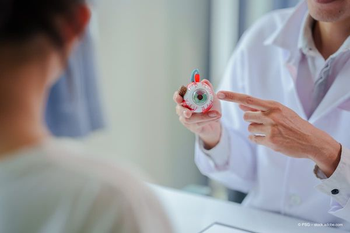
AAO 2023: Children with sickle cell disease suffer from eye complications at the same rate as adults
Study finds that 1 in 3 children with sickle cell disease has retinopathy.
While the inherited disorder in rare, people with sickle cell disease can develop serious vision complications. The disease gets its name from the shape of the red blood cells that become hardened and change shape. Sickle retinopathy is an age-dependent process, with older people being at substantially higher risk, than younger patients.
Researchers at the University of Tennessee Health Science Center conducted a large, retrospective review at their institution with surprising results: 1 in 3 children had retinopathy, of which 9 percent required treatment. These findings suggest children need to be screened for vision problems as often as adults with sickle cell disease.1
Lead researcher, Mary Ellen Hoehn, MD, professor of Ophthalmology at University of Tennessee Health Science Center shared the importance of “Our data underscores the need for patients— including pediatric patients— with sickle cell disease to get routine ophthalmic screenings along with appropriate systemic and ophthalmic treatment.” 1
In an evaluation of therapies for this condition, Hoehn and colleagues also found that hydroxyurea and chronic transfusions were associated with decreased rates of retinopathy, even when accounting for different genotypes.1
To conduct the study, the team evaluated records for 652 patients, aged 10 to 25 years (median age: 14) who underwent eye exams (2,240 visits) over a 12-year period. They found:
- 33 percent had nonproliferative retinopathy (NPR).
- 6 percent had proliferative retinopathy (PR).
- 33 eyes were treated with panretinal photocoagulation, most commonly for PR stage 3 (43 percent). Intravitreal anti-VEGF therapy was given to five eyes, all with PR.
- Other complications included retinal detachment and retinal artery occlusion in two patients each.
- Vision loss (final best corrected visual acuity 20/60) following complications from sickle cell disease was noted in only one patient with a central retinal artery occlusion.
“We hope that people will use this information to better care for patients with sickle cell disease, and that more timely ophthalmic screen exams will be performed so that vision-threatening complications from this disease are prevented,” Hoehn said.1
Reference:
Children with sickle cell disease appear to suffer eye complications at same rate as adults. American Academy of Ophthalmology. November 4, 2023. Accessed November 6, 2023. https://www.aao.org/newsroom/news-releases/detail/children-with-sickle-cell-disease-appear-to-suffer
Newsletter
Keep your retina practice on the forefront—subscribe for expert analysis and emerging trends in retinal disease management.













































